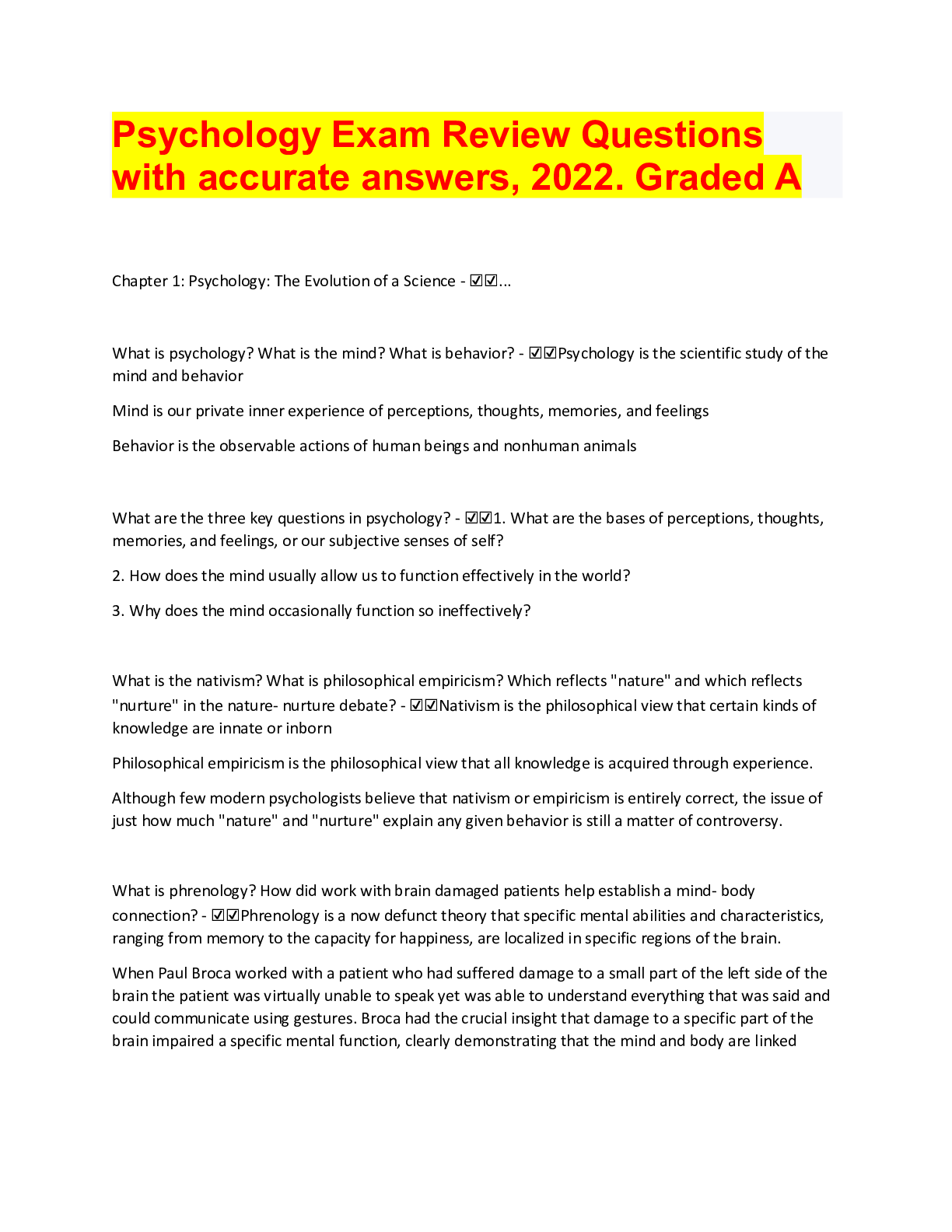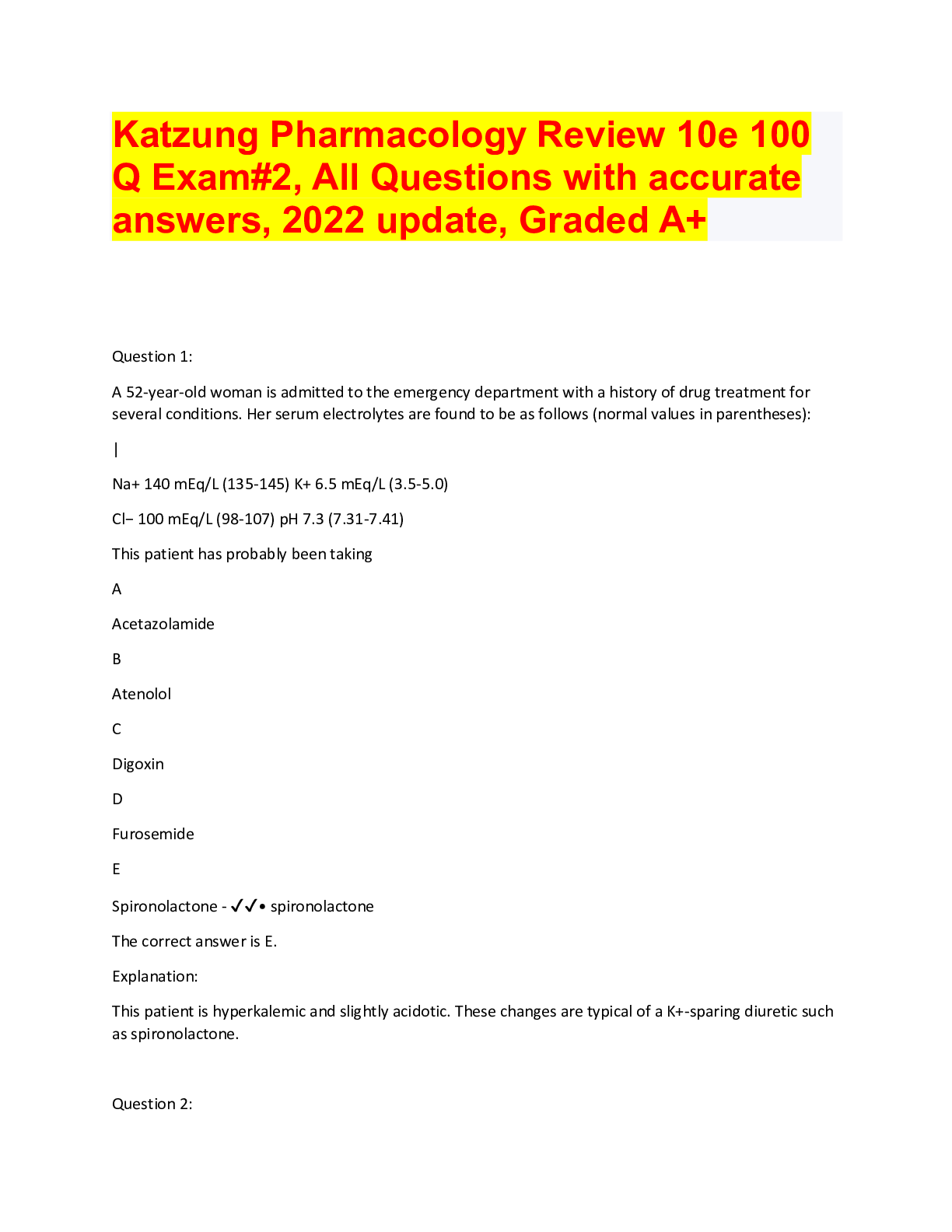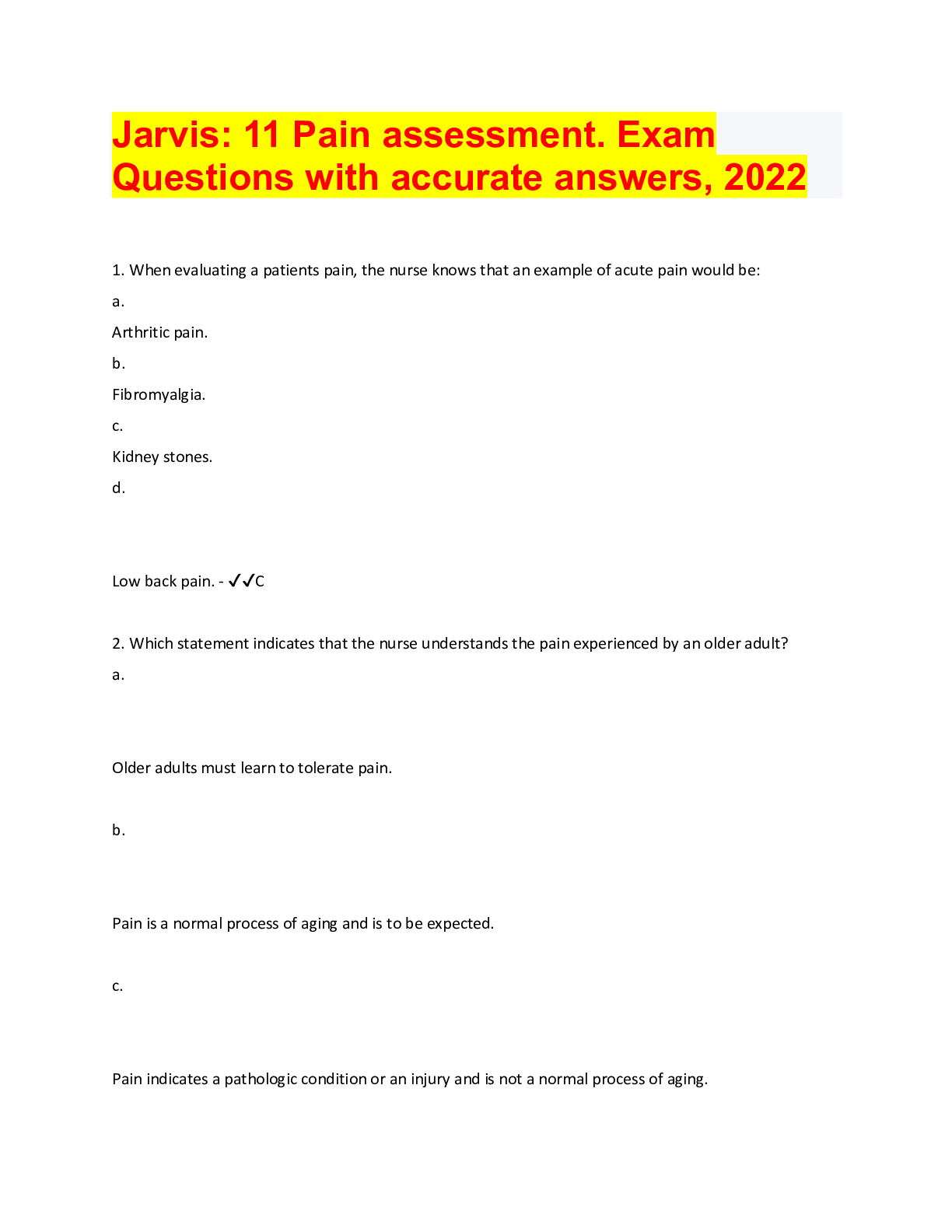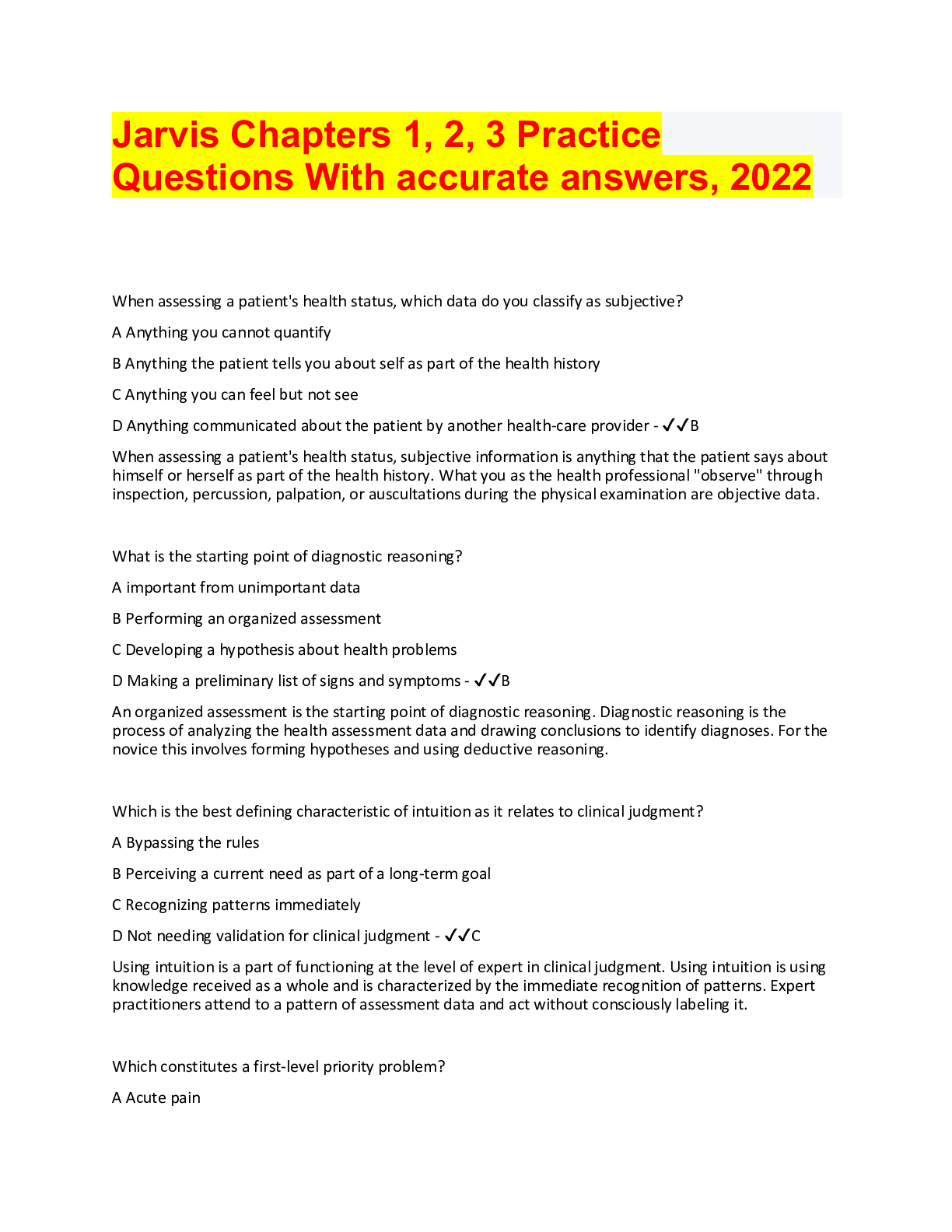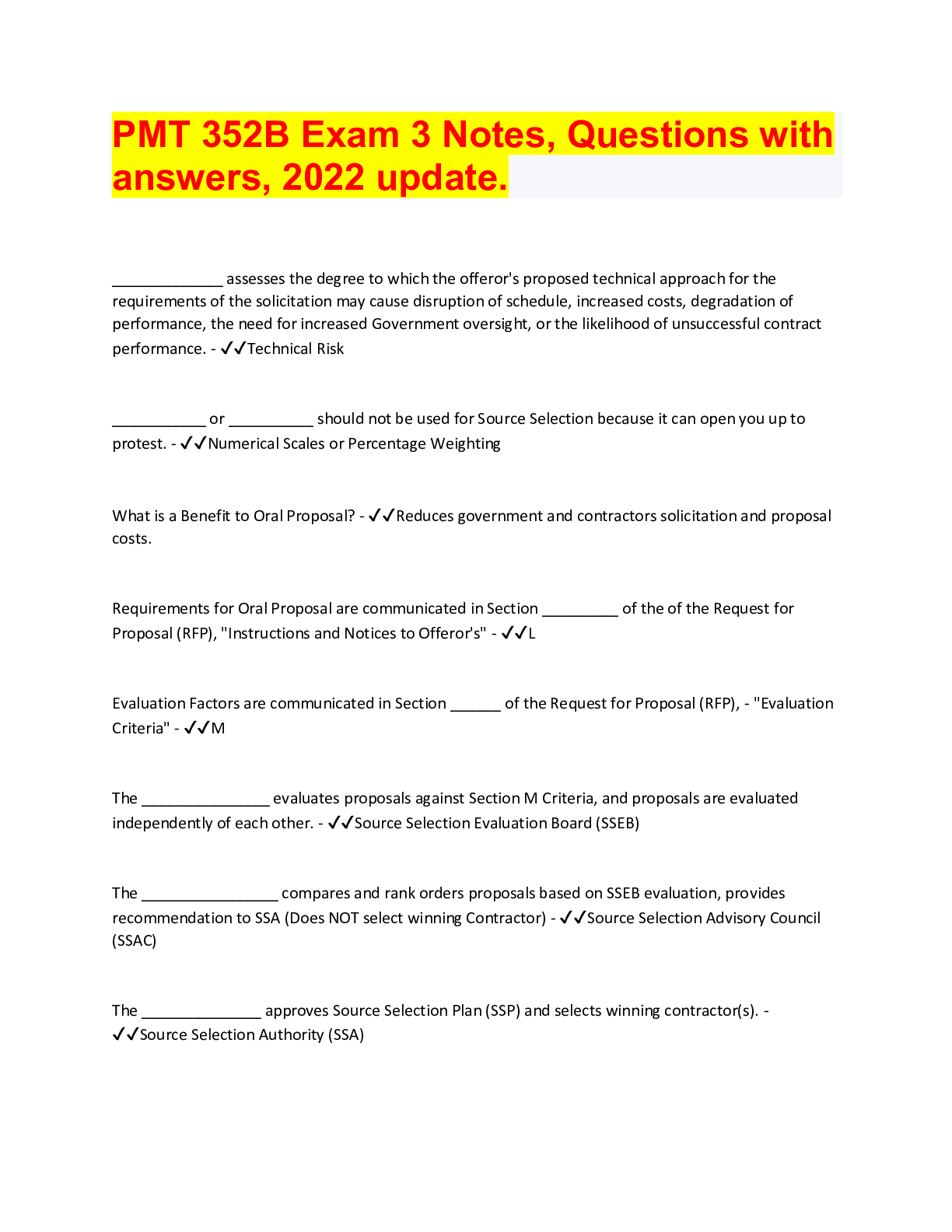*NURSING > QUESTIONS & ANSWERS > PA Easy Cardio, Questions with accurate answers, 2022 update. 100% pass rate. (All)
PA Easy Cardio, Questions with accurate answers, 2022 update. 100% pass rate.
Document Content and Description Below
PA Easy Cardio, Questions with accurate answers, 2022 update. 100% pass rate. What is the most common electrolyte that can effect the initiation of ventricular tachycardia? - ✔✔Hypomagnesia a... nd hypokalemia are the two electrolyte disorders for ventricular tachycardia. infant brought in for evaluation of cyanosis x 2 days most evident when he is feeding or crying. a grade III/VI systolic ejection murmur is present at the left sternal border in the third intercostal space, and radiates to the back - ✔✔this is a "tet spell" - Tetralogy of Fallot Neonate with profound cyanosis and no significant murmur - ✔✔Transposition of the great arteries upraventricular tachycardia (SVT). His history shows that he has had multiple episodes of SVT. long term med to manage? - ✔✔Flecanide (antiarrhthymic) doses up to 200 mg BID can be used to help control rate and prevent recurrences of reentry tachycardias. 60-year-old marathon runner has noticed a progressive decline in his exercise tolerance over the past year and notices increased lower extremity edema. On physical exam, a grade 2/6 crescendo-decrescendo murmur is noted, radiating to the carotid arteries. - ✔✔Bicuspid aortic valve with severe stenosis The patient's PE findings are pathognomonic for aortic stenosis elderly Hx valve replacement. On physical exam, a new high-pitched, blowing, decrescendo diastolic murmur is noted along the left lower sternal border. Two separate blood cultures are positive for S. aureus, and found to be methicillin-resistant. A transesophageal echocardiogram demonstrates a paravalvular abscess. Which of the following is the most appropriate therapy in the management of this patient? - ✔✔endocarditis. In patients with prosthetic valve infection with methicillin-resistant S. aureus, the treatment of choice is IV vancomycin for 6 to 8 weeks, plus IV or IM gentamicin for the initial 2 weeks secondary to nephrotoxicity, and PO rifampin for 6 to 8 weeks, with susceptibility to gentamicin determined before initiation of rifampin. Surgical therapy decreases mortality in patients with S. aureus endocarditis, from over 70% with medical therapy alone to 25%, and should be considered in patients with paravalvular abscesses and symptoms suggestive of moderate to severe refractory congestive heart failure tenderness sensitivity of the scalp. jaw and neck pain. inflammatory disease of blood vessels. what is biggest complication? MC females > 55yrs - ✔✔giant cell (temporal) arteritis. blindness most feared complication. prevented by prompt initiation of high dose prednisone egg on a string CXR - ✔✔Transposition of the Great arteries boot-shaped heart - ✔✔tetralogy of fallot infant with II/VI murmur along the left sternal border, which radiates into the left axilla and the left side of the back. The child also has decreased femoral pulses bilaterally. blowing systolic murmur disease and what will you see on CXR - ✔✔coarctation of the aorta. pathognomonic is decreased/absent femoral pulse. childhood unequal pulses and BP between arms and legs you will see scalloping/notching of the ribs What is the peak incidence of age for a patient who presents with acute rheumatic heart disease? - ✔✔5-15 yrs In symptomatic patients demonstrating significant aortic stenosis, what is the best treatment - ✔✔aortic valve replacement after cardiac catheterization, to evaluate for coronary artery disease and possible concomitant coronary artery bypass surgery with aortic valve replacement, is indicated. pt with history of rheumatic fever. Mitral stenosis with opening snap, loud S1 and rumbling murmur. On transthoracic echocardiogram, which of the following findings is most likely to be seen in addition to mitral valve stenosis? - ✔✔tricuspid stenosis, is frequently seen in association with mitral valve stenosis in patients with a history of rheumatic heart disease (between 5% and 10% of the time). Both murmurs are similar in character, with the main difference that the murmur of tricuspid stenosis is heard best at the left lower sternal border (mitral stenosis LLD with bell) delta waves on EKG and anatomic pathway that is known to be the causative abnormality in this dz - ✔✔wolf parkinson white syndrome Bundle of Kent A syndrome in which an extra electrical pathway in the heart causes a rapid heartbeat. "feeling like I am going to die. Out of the blue I feel real nervous, I get a splitting headache, break out in a sweat, and even feel like I am trembling. Sometimes I feel my heart beating out of my chest but don't have any pain or shortness of breath." all tests done are negative. PMHx uncontrolled HTN - ✔✔pheochromocytoma. plasma fractionated free metanephrines v sensitive test for dx Cardiac marker that remains elevated one week after an MI - ✔✔Troponin elevation in acute myocardial infarction may be noted within two hours after myocardial infarction. It is usually elevated within 6 to 10 hours, peaks at 12 hours, and may remain elevated for 7 to 10 days; hat is the most likely reason for a patient to have cardiogenic shock? - ✔✔Acute MI a fixed and widely split S2, a right ventricular heave, and a systolic ejection murmur present. The murmur is heard best at the left sternal border second intercostal space. What is the most likely diagnosis? - ✔✔Atrial Septal Defect African American with CHF, tachycardia, CXR shows pleural effusions and PE shows pitting edema. Which HTN med also is used for rate control and will help with the tachycardia - ✔✔Beta Blockers Patients Fasting Labs. His total cholesterol = 230 mg/dl, triglycerides = 1200 mg/dl, unable to calculate LDL. He is at risk for what? - ✔✔Pancreatitis Very elevated triglycerides, especially over 1000 mg/dl, increase the patient's risk of acute pancreatitis. This patient requires prompt treatment. Examination of a female newborn demonstrating cyanosis after feeding reveals a systolic ejection click that is heard best at the third left intercostal space, and a short grade III/VI systolic ejection murmur that is heard best at the second left intercostal space. Given this patient's physical exam findings, which murmur is the most likely finding on an echocardiogram? - ✔✔Pulmonic stenosis, frequently presents with a newborn presenting with cyanosis after feeding, and a systolic ejection murmur. Congenital pulmonic stenosis occurs in 1 in 10 patients with congenital heart disease. A 77-year-old female admitted to the hospital for ACS. Initial vital signs: temperature is 99.0, pulse rate is 140, blood pressure is 100/65, and respiratory rate is 16. An initial bolus and infusion of amiodarone was started, with little success of slowing the rate or converting the patient's rhythm. About an hour later, the blood pressure dropped to 80/55 and she was becoming diaphoretic, with increased dyspnea and some mild chest discomfort. What is the next step in treating this patient? - ✔✔Synchronized Cardioversion This patient has unstable, sustained ventricular tachycardia. Because of the symptoms, and most importantly the BP, it is critical to intervene immediately to prevent a cardiac arrest. A 9-year-old female child presents with tachycardia, tachypnea, shortness of breath, bibasilar rales, and distended jugular veins. Which of the following is the most likely cause for her signs and symptoms? - ✔✔patent ductus arteriosus Pt is presenting with signs of CHF. The MCC of heart failure in children are due to acquired heart disease. Congenital heart diseases, such as malformations of the heart—PDA and ventricular septal defects, are the most common causes of heart failure in infants-toddlers, and are second to fluid overload in neonates. A 67-year-old woman with hx of gastric ulcers is admitted with complaints of recent onset of dyspnea with exertion, 3 pillow orthopnea, lower extremity edema, and palpitations, in which she describes her heart as racing. What is the likely cause of her high-output CHF? - ✔✔severe anemia May result with progression of gastric ulcers, and is the only high-output cause of congestive heart failure. Other causes include thyrotoxicosis, and arteriovenouis shunting (for example, in hemodialysis patients Framingham criteria Diagnosis of CHF requires the simultaneous presence of at least 2 major criteria or 1 major criterion in conjunction with 2 minor criteria. - ✔✔Major criteria: · Paroxysmal nocturnal dyspnea · Neck vein distention · Rales · Radiographic cardiomegaly · Acute pulmonary edema · S3 gallop · Increased central venous pressure (>16 cm H2O at right atrium) · Hepatojugular reflux · Wt loss >4.5 kg in 5 days in response to tx Minor criteria: · Bilateral ankle edema · Nocturnal cough · Dyspnea on ordinary exertion · Hepatomegaly · Pleural effusion · Decrease in vital capacity by 1/3 from max recorded · Tachycardia (HR>120 beats/min.) A 24-year-old man with a recent history of a viral illness comes to the ER complaining of severe left-sided chest discomfort, which radiates through to the left trapezius region. On coming into the room, you note that he is sitting up and hunched forward. On PE a pericardial friction rub is noted. Laboratory findings demonstrate elevated serum creatine kinase levels and normal serial troponin levels. His EKG demonstrates peaked T waves. His CXR demonstrates no acute process. Which of the following is the most appropriate treatment for this patient? - ✔✔Indomethacin 25-75 mg QID, and bed rest would be the most appropriate treatment in a patient with acute viral pericarditis, as a NSAID will ameliorate the inflammatory process. Hypertensive emergency treatment - ✔✔IV labetalol An adult with a high risk for bacterial endocarditis is scheduled for a dental extraction. The pt has hx of penicillin allergy. What is an appropriate oral prophylactic drug to give this patient? - ✔✔Clindamycin Recommended that patients who are at moderate to high risk for bacterial endocarditis receive abx prophylaxis prior to undergoing oral/dental, respiratory tract, or esophageal procedures. Amoxicillin 2.0 g orally 1 hour before the procedure is the standard regimen. Patients who have a history of amoxicillin/penicillin allergy may be given clindamycin, cephalexin, azithromycin, or clarithromycin. For adults, clindamycin is given at a dose of 600 mg po 1 hour before the procedure Of the following diseases, which would you consider screening for first in a 55-year-old diabetic with no other comorbidities - ✔✔peripheral arterial disease with an ABI A 42-year-old male comes to the office to discuss his total cholesterol of 215 mg/dl, which was obtained last week at a health fair. He is generally healthy, but smokes one pack of cigarettes per day for the past 10 years. He is unsure of his family history. What is your next step? - ✔✔obtain a fasting lipid profile e patient comes in only with total cholesterol. With this information a fasting lipid profile is indicated to evaluate the patient's cardiovascular risk 18-year-old female complaint of palpitations for the last 2 months. The episodes are frequent and accompanied with lightheadedness and SOB. Some episodes the rate gets as high as 170 beats/min. Her resting pulse is 55 and her BP is 122/65. An ECG is obtained showing delta waves. Best pharmacologic treatment plan for this patient? - ✔✔Tx = Flecanide Dx = Wolff-Parkinson-White syndrome generally occur in individuals at the onset of early adulthood. Mgmt for this includes the use of class IC drugs, such as flecanide. Other choices include procainamide, sotalol, and amiodarone. Digoxin C/I - may worsen and widen the QRS complex and place the patient into a ventricular tachycardia. 57-year-old woman with a hx of rheumatic fever complaining of dyspnea while vacuuming worsening over the last few months. On PE, a very soft systolic murmur is auscultated. With inspiration, the murmur increases, and is heard best at the left lower sternal border. A large and early v jugular venous wave is noted. most likely finding on echocardiogram? - ✔✔tricuspid regurgitation, patient with a hx of rheumatic fever presenting with a systolic murmur that increases with inspiration. It is heard best at the left lower sternal border. Tricuspid stenosis is also frequently seen in association with tricuspid regurgitation. The murmur of tricuspid stenosis, however, is a diastolic murmur, which increases with inspiration, and is also heard best at the left lower sternal border. Your patient is a 47-year-old female who complains of leg cramps and fatigue over the past few weeks. Her examination is completely normal. She is taking an unknown medication for hypertension, which she did not bring with her. Labs include a normal complete blood count (CBC) and a BMP that reveals a potassium level of 3.2 m Eq/L, otherwise normal. Which of the following is the most likely cause of her laboratory abnormalities? HCTZ ACE ARB BB CCB - ✔✔HCTZ pt sxs d/t hypokalemia, a potential side effect of thiazide diuretics. Hyponatremia may also be another possible side effect. ACE and ARB can cause hyperkalemia. BB and CCB do not cause hypokalemia What is the most common congenital heart malformation - ✔✔ventricular septal defect accounts for 30% of cases of congenital heart disease. Atrial septal defect occurs in approximately 10% of congenital heart disease cases. A 55-year-old woman hx of emphysema, who is undergoing chemotherapy for lung CA, is sent to see you regarding a sudden increase in dyspnea, with exertion and fatigue. Physical exam finding would predict a cardiac etiology for her dyspnea instead of a pulmonary etiology? - ✔✔pulses paradoxus frequently seen in patients with cardiac tamponade. Patients diagnosed with cancer, particularly of the lung and breast, may accumulate fluid within the pericardial sac, leading to cardiac tamponade. The finding of pulsus paradoxus is defined as a decrease in systolic arterial pressure of greater than 10 mmHg. It is an accentuation of the normal decrease in systolic arterial pressure of less than 10mm Hg that normally accompanies inspiration. Symptoms of dyspnea and fatigue in a patient with lung cancer and emphysema are not uncommon. A 64-year-old female presents to the office with a complaint of retrosternal chest pain, painful swallowing, and difficulty swallowing. The symptoms occur about three hours after she takes a daily medication. Which of the following medications is most likely to be the cause of her symptoms? A. lisinopril B. Alendronate C. Levothyroxine D. Yaz E. Rosuvastatin - ✔✔Alendronate known to cause esophagitis. The other choices are very unlikely to cause pill-induced esophagitis. A 62-year-old man presents to the office concerned about an abdominal aortic aneurysm (AAA). He has had no symptoms but states that his father died from an aortic dissection at the age of 50 and his brother was diagnosed last week with an AAA. What is the most appropriate screening tool in this situation? - ✔✔Ultrasonography is cost-effective and is the most commonly utilized screening modality for AAAs. It can be utilized for initial detection of a nonruptured AAA and for monitoring of progression. A 57-year-old man with a hx of HTN, hyperlipidemia, and chronic tobacco use, presents with complaints of chest tightness that occurs every time he begins raking leaves. If he stops and rests, it is relieved within 5 minutes. He has associated dyspnea. Most appropriate next step in the management of this patient? - ✔✔Exercise nuclear stress test provide information regarding exercise tolerance and exercise-induced dysrhythmias, as well as information regarding myocardial ischemia. A 29-year-old female has a long hx of SVT, for which she has been treated with long-term flecanide, as well as prior therapy with verapamil. She continues to have repeated episodes, sometimes 2-3x/week, along with SOB and at times hypotension that has been recorded. What is the next best therapy for this patient? - ✔✔Ablation therapy After exhaustion of non-invasive therapies, ablation therapy can be used to try to negate the aberrant pathway for SVT. A 2-month-old female presents for a well child check. The mother has no concerns and feels that the child is doing well. On exam, there is a fixed and widely split S2, a right ventricular heave, and a systolic ejection murmur present. The murmur is heard best at the left sternal border second intercostal space. What is the most common abnormality present on an ECG? - ✔✔Right axis deviation The most likely diagnosis is an atrial septal defect, which usually shows right axis deviation on ECG. pt with increasing exertional dyspnea, cough for the past week. PE: S3 gallop, mild JVD, and 2+ pitting edema of the bilateral lower extremities. CXR: prominent pulmonary vasculature The pt had mild CHF in the past. What cardiac marker is released by the ventricular myocardium in response to elevated ventricular pressure and overload? - ✔✔BNP B-type natriuretic peptide (BNP) and N-terminal pro-BNP, provide representation of the ventricular response to volume and pressure overload, and are elevated in hypervolemic states. These markers diagnostic and used to monitor CHF prognosis and progression. unstable pt with bp of 70/40 and in v-fib appropriate mgmt? - ✔✔unsynchronized cardioversion [Show More]
Last updated: 3 years ago
Preview 1 out of 27 pages

Buy this document to get the full access instantly
Instant Download Access after purchase
Buy NowInstant download
We Accept:

Also available in bundle (1)

PA easy bundle, Exam Questions and answers, Rated A+
Comprises of exam Questions and answers, latest revisions for exams
By bundleHub Solution guider 2 years ago
$38
11
Reviews( 0 )
$13.00
Can't find what you want? Try our AI powered Search
Document information
Connected school, study & course
About the document
Uploaded On
Aug 20, 2022
Number of pages
27
Written in
Seller

Reviews Received
Additional information
This document has been written for:
Uploaded
Aug 20, 2022
Downloads
0
Views
118

















